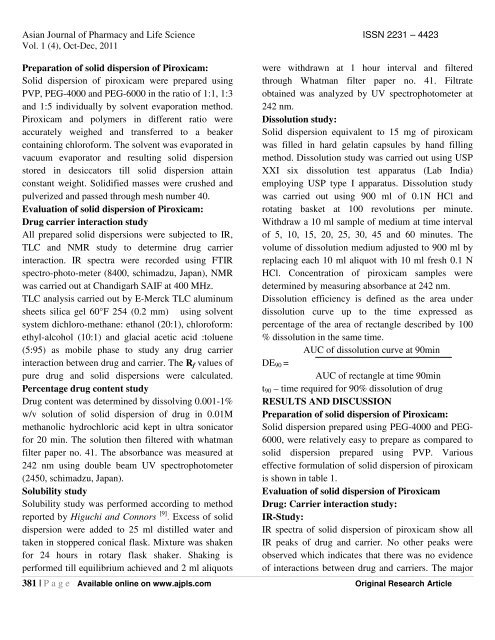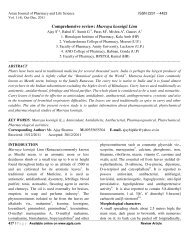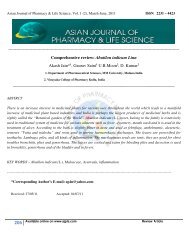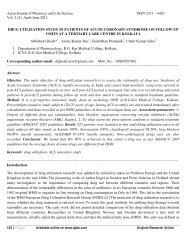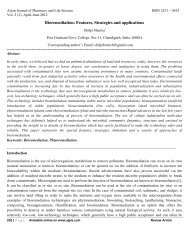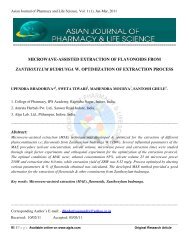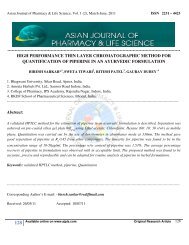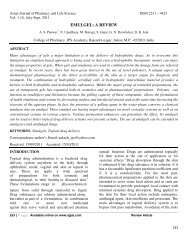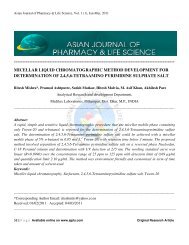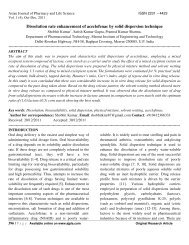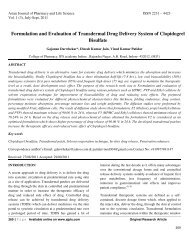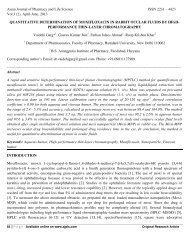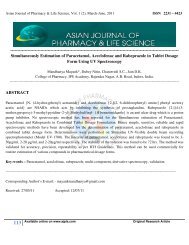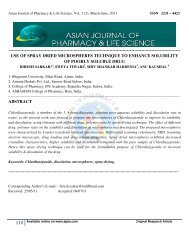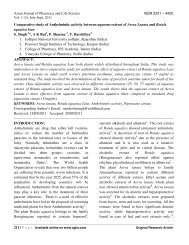Asian Journal of Pharmacy and Life Science ISSN 2231 – 4423 Vol. 1
Asian Journal of Pharmacy and Life Science ISSN 2231 – 4423 Vol. 1
Asian Journal of Pharmacy and Life Science ISSN 2231 – 4423 Vol. 1
Create successful ePaper yourself
Turn your PDF publications into a flip-book with our unique Google optimized e-Paper software.
<strong>Asian</strong> <strong>Journal</strong> <strong>of</strong> <strong>Pharmacy</strong> <strong>and</strong> <strong>Life</strong> <strong>Science</strong> <strong>ISSN</strong> <strong>2231</strong> <strong>–</strong> <strong>4423</strong><br />
<strong>Vol</strong>. 1 (4), Oct-Dec, 2011<br />
Preparation <strong>of</strong> solid dispersion <strong>of</strong> Piroxicam:<br />
Solid dispersion <strong>of</strong> piroxicam were prepared using<br />
PVP, PEG-4000 <strong>and</strong> PEG-6000 in the ratio <strong>of</strong> 1:1, 1:3<br />
<strong>and</strong> 1:5 individually by solvent evaporation method.<br />
Piroxicam <strong>and</strong> polymers in different ratio were<br />
accurately weighed <strong>and</strong> transferred to a beaker<br />
containing chlor<strong>of</strong>orm. The solvent was evaporated in<br />
vacuum evaporator <strong>and</strong> resulting solid dispersion<br />
stored in desiccators till solid dispersion attain<br />
constant weight. Solidified masses were crushed <strong>and</strong><br />
pulverized <strong>and</strong> passed through mesh number 40.<br />
Evaluation <strong>of</strong> solid dispersion <strong>of</strong> Piroxicam:<br />
Drug carrier interaction study<br />
All prepared solid dispersions were subjected to IR,<br />
TLC <strong>and</strong> NMR study to determine drug carrier<br />
interaction. IR spectra were recorded using FTIR<br />
spectro-photo-meter (8400, schimadzu, Japan), NMR<br />
was carried out at Ch<strong>and</strong>igarh SAIF at 400 MHz.<br />
TLC analysis carried out by E-Merck TLC aluminum<br />
sheets silica gel 60°F 254 (0.2 mm) using solvent<br />
system dichloro-methane: ethanol (20:1), chlor<strong>of</strong>orm:<br />
ethyl-alcohol (10:1) <strong>and</strong> glacial acetic acid :toluene<br />
(5:95) as mobile phase to study any drug carrier<br />
interaction between drug <strong>and</strong> carrier. The Rf values <strong>of</strong><br />
pure drug <strong>and</strong> solid dispersions were calculated.<br />
Percentage drug content study<br />
Drug content was determined by dissolving 0.001-1%<br />
w/v solution <strong>of</strong> solid dispersion <strong>of</strong> drug in 0.01M<br />
methanolic hydrochloric acid kept in ultra sonicator<br />
for 20 min. The solution then filtered with whatman<br />
filter paper no. 41. The absorbance was measured at<br />
242 nm using double beam UV spectrophotometer<br />
(2450, schimadzu, Japan).<br />
Solubility study<br />
Solubility study was performed according to method<br />
reported by Higuchi <strong>and</strong> Connors [9] . Excess <strong>of</strong> solid<br />
dispersion were added to 25 ml distilled water <strong>and</strong><br />
taken in stoppered conical flask. Mixture was shaken<br />
for 24 hours in rotary flask shaker. Shaking is<br />
performed till equilibrium achieved <strong>and</strong> 2 ml aliquots<br />
were withdrawn at 1 hour interval <strong>and</strong> filtered<br />
through Whatman filter paper no. 41. Filtrate<br />
obtained was analyzed by UV spectrophotometer at<br />
242 nm.<br />
Dissolution study:<br />
Solid dispersion equivalent to 15 mg <strong>of</strong> piroxicam<br />
was filled in hard gelatin capsules by h<strong>and</strong> filling<br />
method. Dissolution study was carried out using USP<br />
XXI six dissolution test apparatus (Lab India)<br />
employing USP type I apparatus. Dissolution study<br />
was carried out using 900 ml <strong>of</strong> 0.1N HCl <strong>and</strong><br />
rotating basket at 100 revolutions per minute.<br />
Withdraw a 10 ml sample <strong>of</strong> medium at time interval<br />
<strong>of</strong> 5, 10, 15, 20, 25, 30, 45 <strong>and</strong> 60 minutes. The<br />
volume <strong>of</strong> dissolution medium adjusted to 900 ml by<br />
replacing each 10 ml aliquot with 10 ml fresh 0.1 N<br />
HCl. Concentration <strong>of</strong> piroxicam samples were<br />
determined by measuring absorbance at 242 nm.<br />
Dissolution efficiency is defined as the area under<br />
dissolution curve up to the time expressed as<br />
percentage <strong>of</strong> the area <strong>of</strong> rectangle described by 100<br />
% dissolution in the same time.<br />
AUC <strong>of</strong> dissolution curve at 90min<br />
DE90 =<br />
AUC <strong>of</strong> rectangle at time 90min<br />
t90 <strong>–</strong> time required for 90% dissolution <strong>of</strong> drug<br />
RESULTS AND DISCUSSION<br />
Preparation <strong>of</strong> solid dispersion <strong>of</strong> Piroxicam:<br />
Solid dispersion prepared using PEG-4000 <strong>and</strong> PEG-<br />
6000, were relatively easy to prepare as compared to<br />
solid dispersion prepared using PVP. Various<br />
effective formulation <strong>of</strong> solid dispersion <strong>of</strong> piroxicam<br />
is shown in table 1.<br />
Evaluation <strong>of</strong> solid dispersion <strong>of</strong> Piroxicam<br />
Drug: Carrier interaction study:<br />
IR-Study:<br />
IR spectra <strong>of</strong> solid dispersion <strong>of</strong> piroxicam show all<br />
IR peaks <strong>of</strong> drug <strong>and</strong> carrier. No other peaks were<br />
observed which indicates that there was no evidence<br />
<strong>of</strong> interactions between drug <strong>and</strong> carriers. The major<br />
381 | P a g e Available online on www.ajpls.com Original Research Article


